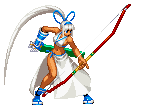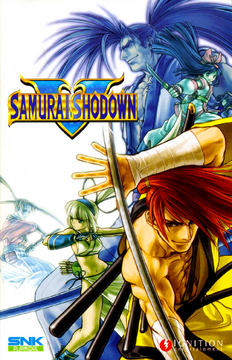| Samurai Shodown V | Stories | Move List | Gallery | Soundtrack |
Samurai Shodown V, known as Samurai Spirits Zero (サムライスピリッツ
Gameplay
Following the revitalization of SNK after its collapse in 2001, the company decided that it would be worthwhile to create another game in the largely-defunct Samurai Shodown series. As part of their reorganization, development duties were given over to the relatively-unknown Yuki Enterprise, which had mainly only created simulation and board games for the Simple 2000 series of PlayStation 2 games in Japan, and had no experience in developing fighting games. This announcement caused considerable unease among series fans.
In spite of this, SNK managed to raise excitement by announcing that Nobuhiro Watsuki, the creator and author of the Rurouni Kenshin manga and anime series, was hired to design some of the new characters, and they were gradually revealed by way of silhouettes on the official website, and slowly showing the official artwork. Word finally got out that the game was to be a true prequel to the rest of the series, taking place two years before Samurai Shodown. This created its own issues with the series timeline.
The gameplay was sped up slightly from Samurai Shodown IV, and the button layout was changed again.
The Slash/Bust system of the last few games was done away with, and each character now only had one version, though in several cases, the Bust mode was replaced by a new character of very similar setup.
Characters
The new characters added to the roster are:
- Yoshitora Tokugawa, the sole heir of the Shogun and the next in the line of Shogunate, is disciple of Gaoh and Jubei Yagyu. More interested in women and partying than politics, he refuses to be the next ruler of Japan, and run away from home;
- Mina Majikina, an exorcist from Ryukyu, who had her village destroyed by a demon. She goes looking for him to exterminate, in the company of a creature called Chample;
- Rasetsumaru, a bloodthristy demon from the world of Makai, opened up by Amakusa. He looks like Haohmaru;
- Rera, a Rasetsu/Bust form of Nakoruru;
- Enja, a disciple of Liu Yunfei who turned a fire demon;
- Suija, a disciple of Liu Yunfei who turned a water demon;
- Liu Yunfei, an old man who made a deal with a demon to obtain more power. He is master of Enja and Suija;
- Youkai Kusaregedo, a gaki with an insatiable appetite who, in the past, was once a very kind man, but when living, he cultivated cannibal habits, which explains his postmortem transformation;
- Tam Tam, a new version of the Mayan warrior, is a priest using the legendary mask in his stead. After the original failed, this new version sets out to save the original;
- Yumeji Kurokouchi, a sole swordsman successor of his father Sakon Kurokouchi, a sensei who also is mentor of Ukyo Tachibana, and disciple of Gaoh;
- Sankuro Yorozu, leader of a trio of minions who want to be lord of Hinowa without much effort, hiring Genjuro Kibagami to kill Gaoh;
- Gaoh, a former loyal serve of Tokugawa clan and lord of Hinowa who, revolted by the Shogun's indifference to the growing famine in Japan, decides to rebel against the Shogunate.
Official Roster
Returning Characters
New Characters
 |
 |
 |
 |
 |
 |
 |
 |
 |
Hidden Character
Mid-Boss
 |
Sub-Boss
Hidden Character
 |
Final Boss
Hidden Character
 |
Stages
- Note 1: This game contains some stages of past games with new versions, and some new stages created exclusively for the game.
- Note 2: Each stage has a special version that appears when a character pops the rage bar.
- Note 3: In this game, the stages are again associated with the character, which hasn't happened in a canonical game of the series since Samurai Shodown III.
- Note 4: In Arcade Mode, Sankuro fights in Haohmaru and Gaira's stages.
Old Stages































The old stages present in the game (as well as their special versions) are:
- Haohmaru's stage from Samurai Shodown III, with two versions: day (associated with him) and night (associated with Rasetsumaru);

- Nakoruru's stage from Samurai Shodown III, in their versions Autumn (associated with her, fighting with Shikuru) and Spring (associated with Sogetsu & Suija);
- Genjuro's stage from Samurai Shodown III;
- Galford's stage from Samurai Shodown III;
- Kyoshiro's stage from Samurai Shodown III;
- Rimururu's stage from Samurai Shodown III, with three versions: night (associated with her), sunset (associated with Nakoruru, fighting with Mamahaha) and day (associated with Rera);
- Shizumaru's stage from Samurai Shodown III, with two versions: misty (associated with him) and sunset (associated with Jubei);
- Basara's stage from Samurai Shodown III, with two versions: night (associated with him) and day (associated with Hanzo);
- Gaira and Nicotine's stage from Samurai Shodown II and III (associated with Gaira, since Nicotine isn't present in the game);
- Funatsu's stage from Samurai Shodown IV, in a day version (associated with Ukyo);
- Fukae's stage from Samurai Shodown IV (associated with Kazuki & Enja).
New Stages
Sunpu (A.K.A. Tokugawa House) — Yoshitora: The main suite of Shogunate's palace, messy, it seems, after a possible party between Yoshitora and his six lovers. Features pillows, a broken table, flags, an altar of devotion, lamps, besides red pillars and a sunset with the Mount Fuji, in the background.
- Special Version: Only the floor of the stage and a red cloud can be seen.
Ryukyu (A.K.A Temple Courtyard) — Mina: The Shuri Castle, in a sunny day, with yellow dragon-shaped roofs. Features ladders, palm trees and shrubs, besides a stylized floor.
- Special Version: A purple aura, and two ayakashis (Chample's true form) can be seen.
Nagakasi (A.K.A. Ship's Helm) — Charlotte & Tam Tam: A floating ship next to the port and the moutains, with two versions: in the first, features ropes, barrels, a red carpet, bags, wooden crates and a white mast sail raised, with a red cross, in a sunny day; in the second, it's evening, and can be spotted the sea and the other side of the port, besides the mast sail lowered.

- Special Versions: In the first, the De Colde's family blazon and red roses can be seen; in the second, the stage features a dark and salmon sky and a blazing floor, besides Mayan statues, an allusion to Tam Tam's birthplace, Green Hell.
Sado (A.K.A. Kusaregedo's Lair) — Kusaregedo: A ditch next to the forest, in a night of full moon and blooded sky. Features a well, shrubs, a wooden cart, crows and a hill of stacked skeletons, and corpses; besides three hanged corpses on a tree. The water on the ground, merges with the blood from the decaying corpse hill. A small graveyard is seen from far-right of the stage.
- Special Version: A green foggy-like athmosphere can be seen in the stage.
Shin (A.K.A. Buddhist Mountain) — Yunfei: A misty cliff, next to the a mountain with Buddha's statue. Features trees, clouds, shrubs and other moutains.
- Special Version: A purple mist can be seen in the stage.
Boss Stages
The Great Battlefield: This stage has two versions. In the first, it's a open field in a firm day, with a a war cavalry and the mountains, in the background. Also features trees, a stone with a Kanji and some flags. In the second version, the war becomes more intense. Features a dark sky, flags and fans fluttering, knights fighting (some already lying on the ground and others wielding swords) and fences. Associated with Yumeji (1st version) and Gaoh (2nd version).
- Special Versions: In the first, the stage is empty; in the second, the stage features green flames, besides a dark and red sky and a circle-shaped cloud.
Critical & Fan Reception
SS5 was a modest success, though not a smash hit. Though fans were glad to see a new installment, the gameplay failed to excite players as much as had been hoped. Common complaints usually revolved around the poor animation on the new characters, and the removal of the Slash/Bust system. Those who were familiar with Samurai Shodown 64: Warriors Rage also noted that the new, alternate characters tended to be heavily watered-down versions of Bust characters in that game (Enja and Suija in particular). The newer characters were considered overpowered, leading to an unbalanced cast. It is more or less commonly regarded as a competent, if unexceptional, fighting game.
Gallery
External link
| This page uses Creative Commons Licensed content from Wikipedia (view authors). |

































